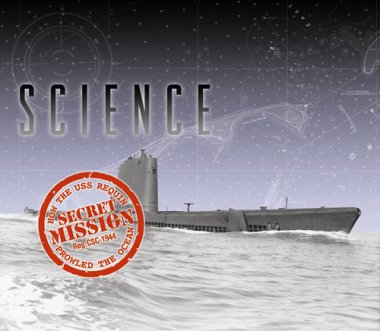
Secret Mission
Learn How the USS Requin Prowled the
Ocean
Ever wonder how submarines detect enemy vessels
in the murky depths? Or why submarines donít bump into whales, the oceanís
craggy bottom and other submarines? Wonder no more. This summer the "crew"
of the Carnegie Science Centerís U.S.S. Requin, a World War II-vintage
submarine, will explain the shipís tactics and instruments. Some things
youíll learn:
-
Why and how active and passive sonar (Sound
Navigation Ranging) are used. How active sonar sends out
"pings" which bounce off objects miles away, sending echoes back to the
submarine and allowing the crew to pinpoint them. Passive sonar reads the
noises of objects surrounding the ship quietly, allowing the submarine
to prowl the ocean undetected by its enemies. Passive sonar is so precise
it can "hear" other ships (big objects, like the Queen Mary, can
be heard 40 miles away), whales and even shrimp! How a SPA 25 Radar Repeater
displays the sonar "blips" of surface objects, thus keeping the submarine
from running into other ships and the coastline.
-
That a fathom meter, another form of active
sonar, bounces pulses off the sea floor to keep the submarine from scraping
bottom.
-
That the submarineís radar (RAdio Detection
And Ranging) system is used when the ship is on the surface,
how it works much like the radar gun police officers use to nab speeders
and how it "sees" -- even through rain and fog -- helping crew members
determine the distance between their ship and land...or the enemy.
-
The different functions of the antennas on
top of the submarine. How a special window on the periscope is used to
view the stars for celestial navigation on cloudy nights when the ship
has to be silent.
-
How the attack periscope is used when the
ship has to be as invisible as possible.Ö
While you wonít be able to look through
the Requinís periscope, you will be able to view topside activities
at Point State Park and the Fort Pitt Bridge on a shipboard television
screen, thanks to a camera mounted on the periscope.
Visitors will also get an auditory treat from
a new sound system expected to be installed this summer. According to Submarine
Manager Scott Kleinshnitz, the sounds of torpedoes, sonar pings, collisions
and alarms "will make the ship come alive and help immerse visitors in
the experience."
Call (412) 237-3400 for tour times. Because
of the length and technical nature of the tour, it is not recommended for
children under age 3. Groups of 15 or more should call for a reservation. |

